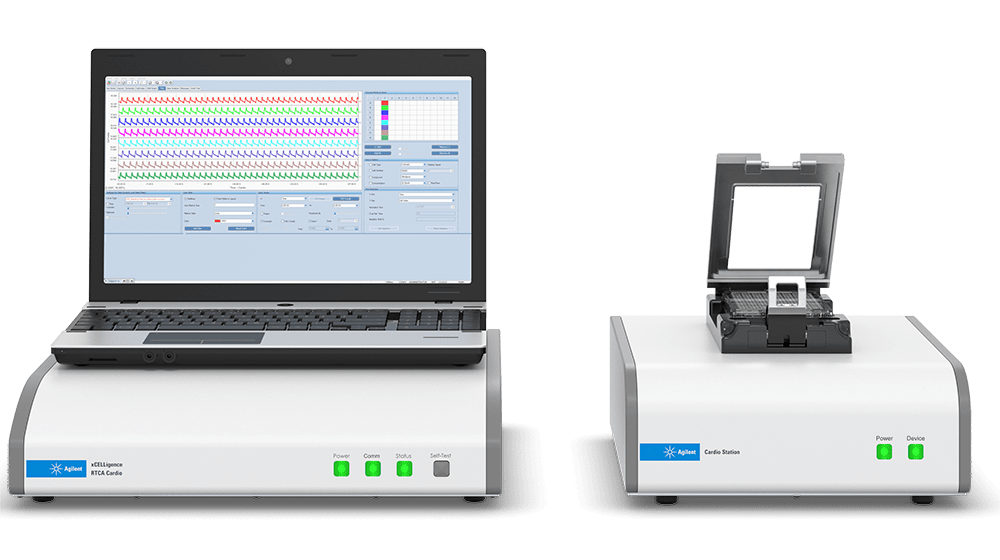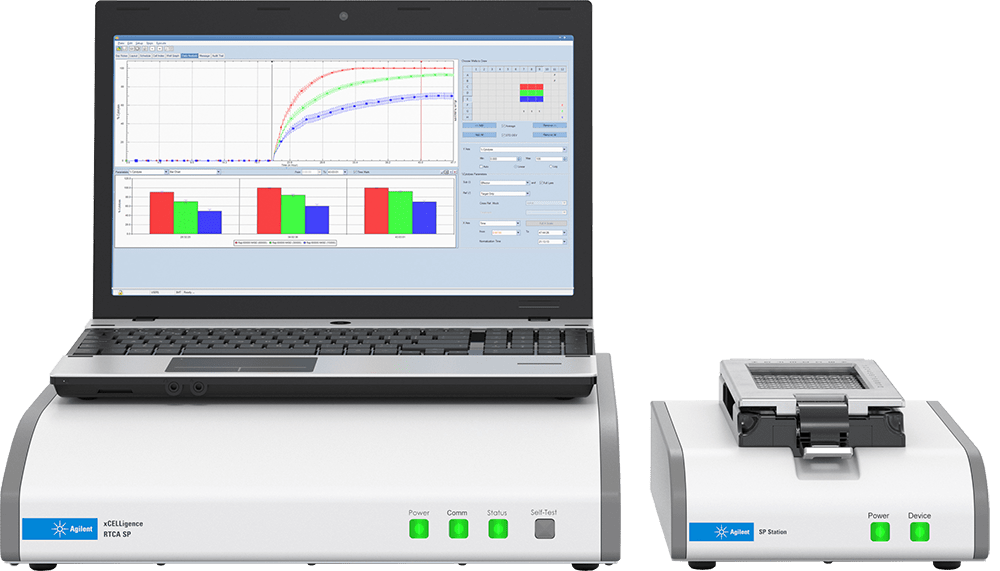xCELLigence RTCA Cardio
Information
Overview
The xCELLigence RTCA Cardio instrument monitors cardiomyocyte activity for cardiotoxicity assessment. The contraction-relaxation cycle of cardiomyocytes gives rise to a distinct, rhythmic fluctuation in impedance that is readily captured on the millisecond time scale. Changes in the intensity and periodicity in impedance are monitored in seconds or in days to assess cardiomyocyte contractility and viability in the presence of various drugs.
The xCELLigence RTCA Cardio instrument, which analyzes cells in an electronic 96-well microtiter plate format (E-Plate Cardio 96), is placed in a standard CO2 cell culture incubator and interfaces via a cable with analysis and control units that are housed outside the incubator. User friendly software allows for real-time control and monitoring of the instrument.
• Correlates findings with arrhythmogenic activity
• Provides insight into compound mechanism of action
-
Compare Cardio versus CardioECR
Cardio CardioECR Recording in incubator ✓
✓
System IMP electrodes ✓
✓
FP electrodes ✓
Electrical pacing function ✓
device plate 96-well E-Plate 48-well E-Plate Application Cell attachment and viability ✓
✓
Contractility ✓
✓
FP (ion channels) assessment ✓
Acute assay (seconds to minutes) ✓
✓
Long-term assay (hours to days) ✓
✓
recording Recording in incubator 96 wells, 12.9 ms Up to 24 wells -1ms; all 48 wells – 2ms Field potential sampling rate n/a 10 kHz Sampling capability Simultaneous recording of impedance in 96 wells Simultaneous recording of impedance and field potential electrodes in all 48 wells stimulation Stimulation voltage range n/a -2.5 V to +2.5 V Simultaneous stimulation n/a Up to 48 wells (across the entire plate) -
Specifications
Analyzer Application Apoptosis Cell Characterization Cytotoxicity Proliferation Stem Cells Cardiotoxicity Depth 34 cm Height 16 cm Operating Environment Relative Humidity 5-98 % Operating Environment Temperature 15-40 °C Sampling Format 96-well plate Width 28 cm -
Applications
Cardiac Disease Modeling
The pathophysiological cellular phenotypes of genetically heritable heart diseases can be modeled using disease-specific human induced pluripotent stem cell cardiomyocyte (hiPSC-CM). Modeling enables broader understanding of the mechanisms leading to compromised electrical and contractile coupling.Cardio Safety Toxicology
Human induced pluripotent stem cell cardiomyocytes (hiPSC-CM) have been used to assess drug liability. The xCELLigence RTCA CardioECR system offers a unique multiplex detection method to probe and understand the underlying toxicity of compounds and pharmaceuticals.Cardio Drug Discovery
Human induced pluripotent stem cell cardiomyocytes (hiPSC-CM) offer an exciting new model system to test both the efficacy and toxicity of new therapeutic approaches, including inotropic compounds that serve to modulate the force of cardiomyocyte contractility.The CiPA (Comprehensive In Vitro Proarrhythmia Assay) Initiative
Driven by HESI, FDA and Safety Pharmacology Society, the CiPA initiative aims to evaluate potential modifications to current regulatory FDA guidelines for cardiac safety assessment. The xCELLigence RTCA CardioECR was selected as a core technology for validation and has participated in Phase I and II. -
How it works
The xCELLigence RTCA Cardio system uses non-invasive, label-free biosensors to continuously evaluate cardiomyocyte health/function in real-time. Cardiomyocytes are seeded in a 96-well electronic microplate microtiter plate (E-Plate Cardio 96) designed with biosensor on bottom of each well. Application of a low voltage (less than 20 mV) establishes an electric current between the biosensors which is differentially modulated by the number of cells covering the biosensors, the morphology of those cells, and the strength of cell attachment (Figure 1A). Cardiomyocyte contraction/relaxation cycle can be dynamically monitored because it involves substantial changes in cell morphology and adhesion (Figure 1B). The fast data acquisition rate (12.9 ms for the entire 96-well plate) of the xCELLigence RTCA Cardio system provides high temporal resolution for viewing subtleties of the cardiomyocyte contraction/relaxation continuum. Flexible monitoring enables the study of both short- and long-term effect of compounds on cardiomyocyte health and function.Software
The user-friendly RTCA Cardio Software provides outstanding instrument control for flexible experiment setups, data acquisition, and data analysis. All instrument and experiment controls are contained in the software to simplify experiment setup and operation. -
Features
The RTCA Cardio instrument offers a way to monitor cardiotoxicity by measuring the fluctuation in impedance caused by cardiomyocyte activity. The contraction-relaxation cycle of cardiomyocytes gives rise to a distinct, rhythmic fluctuation in impedance that is readily captured on the millisecond time scale. Various assessments on drugs and pharmaceuticals can be studied in seconds to days by monitoring the changes in intensity and periodicity of the impedance.
The xCELLigence RTCA Cardio instrument offers a 96-well microtiter plate format. The instrument is placed in a standard CO2 cell culture incubator and interfaces via a cable with analysis and control units that are housed outside the incubator.
Key Features
• Provides a high-throughput method for detecting functional cardiotoxicity effects on short- and long-term cardio beating activity and for general toxicity
• Correlates findings with arrhythmogenic activity
• Provides insight into compound mechanism of actionTypical Applications
• Cardiac disease modelling:
Studying the phenotypes of genetically heritable heart diseases with disease-specific human induced pluripotent stem cell cardiomyocytes (hiPSC-CM).• Cardio Safety Toxicology:
Assess the drugs liability and underlying toxicity of medicine and pharmaceuticals.• Cardio Drug Discovery:
Test the efficacy and toxicity of pharmaceuticals with the usage of human induced pluripotent stem cell cardiomyocytes (hiPSC-CM).
Brochures
Application notes
Please login to be able to see the application notes.

